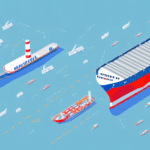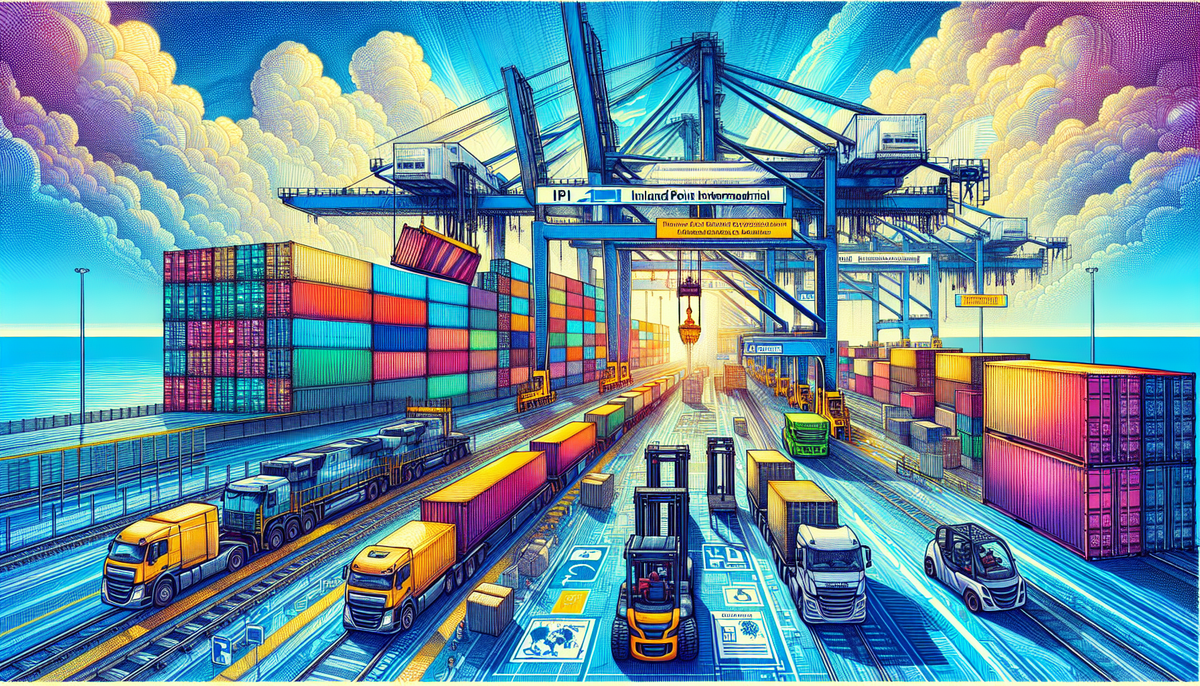Optimizing Domestic Inland Transit for a Successful Supply Chain
In today's fast-paced global economy, businesses must optimize every aspect of their supply chain to remain competitive. Inland transit, which involves moving goods between different locations within a country, plays a critical role in this process. Domestic inland transit offers a cost-effective and reliable way to move goods across different cities and regions within a country, enhancing overall supply chain efficiency.
What is Domestic Inland Transit, and Why is it Important for Supply Chain Optimization?
Domestic inland transit involves moving goods within a country using various modes of transportation, such as trucks, trains, and barges. It is an essential part of the supply chain as it connects different parts of a country and ensures a smooth flow of goods from one location to another. For instance, inland transit can take place between a manufacturing facility and a distribution center, or between a warehouse and a retailer.
According to the U.S. Department of Transportation, efficient inland transit can reduce transportation costs by up to 15%, improve delivery times, and enhance the overall customer experience. By optimizing inland transit processes, businesses can save time and money, increase inventory turnover, and meet customer demands more efficiently.
Another benefit of domestic inland transit is the potential to reduce a company's carbon footprint. Utilizing more efficient modes of transportation, such as trains or barges, can significantly lower greenhouse gas emissions. This not only benefits the environment but also improves a company's reputation and appeals to environmentally conscious consumers.
In addition, domestic inland transit facilitates better inventory management. With a more efficient and reliable transportation system, companies can track their goods more effectively and ensure timely deliveries, reducing the risk of stockouts and overstocking, which can lead to lost sales and increased costs.
Challenges Faced in Domestic Inland Transit and Ways to Overcome Them
Despite its many benefits, inland transit poses significant challenges for businesses. One of the most significant challenges is congestion, which can delay shipments and increase transportation costs. According to the Bureau of Transportation Statistics, transportation congestion in major U.S. cities has increased by 20% over the past year.
Another challenge is the lack of visibility, making it difficult to track shipments promptly. Additionally, changing regulations and compliance requirements can increase operational costs and strain resources.
To overcome these challenges, businesses must invest in advanced technologies and transportation management systems (TMS). These systems can provide real-time visibility into shipment status, optimize routing, improve communication with carriers, and ensure compliance with regulations. Implementing a robust TMS can lead to increased operational efficiency, reduced costs, and enhanced customer service levels.
The risk of damage or loss of goods during transportation is another concern. This can occur due to improper handling, inadequate packaging, or accidents. To mitigate this risk, businesses should ensure that their goods are packaged correctly and securely. Partnering with specialized carriers experienced in handling specific types of goods can also reduce the likelihood of damage or loss.
Furthermore, the lack of standardization in the transportation industry can pose challenges. Different carriers may have varying processes and procedures, making it difficult for businesses to streamline their operations. To address this, businesses can collaborate with carriers that adhere to industry standards and best practices. Establishing clear communication channels with carriers helps ensure consistency and efficiency across the supply chain.
The Role of Technology in Optimizing Domestic Inland Transit
Technology plays a critical role in optimizing domestic inland transit. Advanced transportation management systems can help businesses automate routine tasks, such as tracking shipments, generating invoices, and managing carrier contracts. These systems enhance shipment visibility, route optimization, and carrier performance monitoring, among other benefits.
Emerging technologies such as Artificial Intelligence (AI), Machine Learning (ML), and the Internet of Things (IoT) are revolutionizing the inland transit industry. According to a report by McKinsey & Company, AI and ML can help businesses predict transportation patterns, optimize routing, and enhance delivery times. These technologies also enable the identification of potential issues before they occur, allowing businesses to proactively address them and avoid costly disruptions in the supply chain.
Autonomous vehicles, including self-driving trucks and drones, are another technological advancement optimizing domestic inland transit. These vehicles can operate 24/7, reducing delivery times and increasing productivity. They also have the potential to minimize human error and accidents, enhancing transportation safety.
Moreover, technology is improving the sustainability of inland transit. The adoption of electric and hybrid vehicles is on the rise, reducing emissions and the carbon footprint of transportation. Additionally, transportation management systems help businesses optimize routes to reduce fuel consumption and minimize environmental impact.
Reducing Costs in Domestic Inland Transit While Maintaining Quality of Service
Reducing transportation costs remains a constant challenge for businesses. Inland transit costs can be significantly reduced by optimizing transportation routes, consolidating shipments, and utilizing advanced technologies to improve carrier selection and performance monitoring. Investing in a robust transportation management system can also help businesses reduce the time and resources required for managing transportation operations, resulting in substantial cost savings.
However, it is crucial that cost reductions do not come at the expense of service quality. By investing in advanced technologies and implementing best practices, businesses can maintain high service levels while reducing costs. For example, evaluating carriers based on performance metrics such as on-time delivery, safety, and compliance ensures that businesses partner with reliable carriers who provide high-quality service at competitive prices.
Exploring alternative modes of transportation is another effective strategy to reduce costs without compromising service quality. Intermodal transportation, which involves using multiple transportation modes such as rail, truck, and ship, can result in cost savings and reduced transit times while maintaining high service levels. Additionally, adopting sustainable transportation options like electric or hybrid vehicles can lower costs and positively impact the environment.
Best Practices for Successful Supply Chain Management Using Domestic Inland Transit
Successful supply chain management requires businesses to adopt best practices for domestic inland transit. These best practices include:
- Optimizing transportation routes to minimize costs and improve delivery times
- Implementing advanced technologies such as transportation management systems to enhance visibility, tracking, and communication with carriers
- Consolidating shipments to reduce transportation costs
- Collaborating with carriers to identify areas for improvement and enhance service quality
- Maintaining compliance with regulations and operational standards
Establishing strong relationships with suppliers and customers is another crucial best practice. This collaboration ensures timely and condition-safe deliveries, and can lead to cost savings through improved communication and coordinated efforts.
Regularly reviewing and analyzing supply chain performance is essential for identifying areas for improvement. Tracking key performance indicators (KPIs) such as delivery times, inventory levels, and transportation costs enables businesses to make informed decisions about optimizing their supply chain. Utilizing data analytics tools can provide deeper insights into supply chain performance and highlight opportunities for further optimization.
Case Studies: Successful Implementation of Domestic Inland Transit Strategies for Supply Chain Optimization
Several businesses have successfully implemented inland transit strategies to optimize their supply chains:
- Walmart: Walmart implemented a sophisticated transportation management system to optimize transportation routes, reduce costs, and enhance visibility. This system enabled Walmart to consolidate shipments and collaborate with carriers, resulting in faster and more efficient product deliveries.
- Amazon: Amazon leverages its expansive logistics network to deliver products nationwide at lightning-fast speeds. By utilizing a combination of trucking, air, and rail transportation, Amazon optimizes the delivery process, reduces costs, and enhances the overall customer experience.
- Target: Target employs data analytics to optimize transportation routes and reduce costs. Their system allows real-time shipment tracking, enhancing visibility and enabling quick responses to transportation issues. Additionally, Target incentivizes carriers to use sustainable transportation methods, such as electric trucks and trains, to reduce their carbon footprint.
Future Trends and Innovations in Domestic Inland Transit for Supply Chain Optimization
The future of domestic inland transit is promising, with numerous trends and innovations on the horizon:
- Drones and Autonomous Vehicles: The use of drones and autonomous vehicles for last-mile delivery is expected to increase, enabling businesses to deliver products faster, more efficiently, and cost-effectively.
- Blockchain Technology: Adoption of blockchain technology for tracking and monitoring shipments will enhance the visibility and security of supply chain operations, providing immutable records of transactions.
- Electric Vehicles: With growing environmental concerns, the transition to electric vehicles is accelerating. Electric trucks and hybrid vehicles reduce carbon emissions and operational costs related to fuel and maintenance.
- Artificial Intelligence (AI): Integration of AI in supply chain operations will revolutionize domestic inland transit by predicting demand, optimizing routes, and reducing transportation costs. AI can also identify potential risks and provide real-time solutions to mitigate them.
These innovations will not only enhance the efficiency and reliability of domestic inland transit but also contribute to more sustainable and resilient supply chains.
Evaluating the Performance of Your Domestic Inland Transit Providers
Regularly evaluating the performance of domestic inland transit providers is essential for maintaining an efficient supply chain. This evaluation can involve conducting regular audits, tracking key performance metrics, and collaborating with carriers to identify areas for improvement. By assessing carrier performance, businesses can ensure they are partnering with high-quality carriers who provide reliable service at competitive prices.
On-Time Delivery is a critical metric that measures the percentage of shipments delivered on or before the expected delivery date. Tracking on-time delivery rates helps businesses identify carriers that consistently meet delivery commitments and those that do not. This information can be used to negotiate better rates with reliable carriers and avoid partnerships with carriers that frequently miss delivery deadlines.
In addition to delivery performance, businesses should assess their carriers' safety records. Reviewing a carrier's safety ratings, accident history, and compliance with industry regulations ensures that shipments are transported safely and responsibly. Partnering with carriers that prioritize safety reduces the risk of accidents and enhances the overall reliability of the transportation process.
The Importance of Collaboration with Your Domestic Inland Transit Providers for a Successful Supply Chain
Collaboration with domestic inland transit providers is critical for optimizing supply chains. Working with reliable carriers who provide high-quality service significantly enhances the customer experience and increases operational efficiency. Effective collaboration can help businesses identify areas for improvement, reduce transportation costs, and elevate service quality levels.
Establishing strong relationships with domestic inland transit providers ensures that businesses and carriers are aligned in their goals and objectives. Regular communication and joint problem-solving initiatives foster a collaborative environment where both parties can work together to overcome challenges and implement innovative solutions.
Furthermore, collaborative efforts can lead to the development of customized transportation solutions tailored to the specific needs of the business. This level of partnership can result in more flexible and scalable transportation strategies that adapt to changing market conditions and customer demands.
In conclusion, fostering a collaborative relationship with domestic inland transit providers is essential for achieving a successful and optimized supply chain. By working closely with carriers, businesses can enhance efficiency, reduce costs, and deliver superior service to their customers.




















